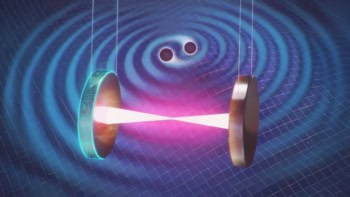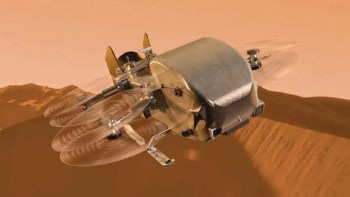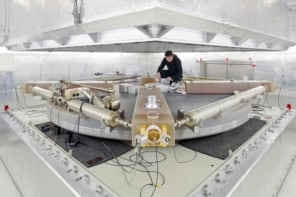
Alternatives to Einstein’s general theory of relativity can be investigated by studying the Sun. That is the claim of a group of physicists in Portugal who have found that a variation of a theory put forward nearly a century ago by Arthur Eddington is constrained but not ruled out by observations of solar neutrinos and solar acoustic waves.
General relativity, which describes gravity as the curvature of space–time by massive objects, has so far passed every experimental and observational test dreamed up by physicists. But the theory does present a number of problems. In addition to the difficulty of unifying it with quantum mechanics and the challenge to explain the nature of dark matter and dark energy, there remains the conceptual problem of singularities, where the laws of physics break down.
Since Einstein introduced general relativity in 1916, many alternatives have been proposed. Last year Máximo Bañados of the Pontifical Catholic University in Chile and Pedro Ferreira of Oxford University reported a variant of a theory originally put forward by the British astrophysicist Arthur Eddington that adds a repulsive gravitational term to general relativity. This has the virtue of not requiring singularities, and as a result does not predict that the universe originated from a Big Bang, nor does it imply the formation of black holes.
Looking inside a star
When considering a gravitational field within a vacuum, this Eddington-inspired theory is equivalent to general relativity but predicts different effects for gravity acting within matter. The ideal place to look for such differences would be inside neutron stars – but the interiors of neutron stars are not understood sufficiently to compare the theories.
The answer, say Jordi Casanellas and colleagues at the Technical University of Lisbon, is to use the Sun. While a much less extreme source of gravity than a neutron star, the inner workings of the Sun are described accurately by solar models. Casanellas’s group has calculated that even in its non-relativistic Newtonian form, the Eddington-inspired theory should predict measurable differences in solar output compared with standard gravitational theory.
The Lisbon researchers have shown that the presence of the repulsive gravity term in the theory of Bañados and Ferreira is similar to setting a different value for the gravitational constant inside matter. And with the strength of gravity higher or lower than it would otherwise be inside the Sun, the inner solar temperature is also modified because the Sun is assumed to be in hydrostatic equilibrium. This means that the inward pressure of its mass is balanced by the outward thermal pressure generated by the fusion reactions within it. A higher temperature implies a greater rate of fusion burning, which in turn implies higher emission rates of solar neutrinos.
Altering acoustic waves
Similarly, a different strength of gravity inside the Sun implies a variation in its density distribution, which should modify the propagation of acoustic waves measured using the techniques of helioseismology.
Casanellas and co-workers have shown that observations made by neutrino telescopes of the solar neutrino flux coming from the proton–proton chain reaction that produces boron-8 significantly constrain the correction to general relativity, calculating an upper limit of 1.26 G to the effective gravitational constant. Combined with a lower limit of 0.92 G obtained from helioseismic data, the researchers are able to put a significant constraint on the Eddington-inspired theory. However, they point out that their calculations do not rule out such a theory.
The researchers say that improving on these upper and lower limits will be difficult because of uncertainties in a few of the parameters within solar models, such as the abundance of helium on the solar surface. As such, more sensitive measurements of neutrino fluxes are unlikely to have much of an impact. But they believe their approach could be used to constrain other alternative theories of gravity.
Further testing on Earth
Ultimately, adds team member Paolo Pani, such theories could be tested experimentally by measuring, for example, the gravitational attraction between a metal ball inserted into a hole in the ground and the mass of the Earth surrounding it. The idea would be to make the hole just big enough for the ball to fit and no more, so that what is measured is the strength of gravity through matter and not the surrounding void (in this case air). However, Pani points out that doing so would be a considerable experimental challenge.
Clifford Will of Washington University in St Louis, US, described the latest work as a “nice example of using the Sun as a laboratory for probing fundamental physics” but added that “it’s not yet clear whether the bounds proposed by this paper present serious threats to alternative gravity theories”.
The research is reported at arXiv:1109.0249.



